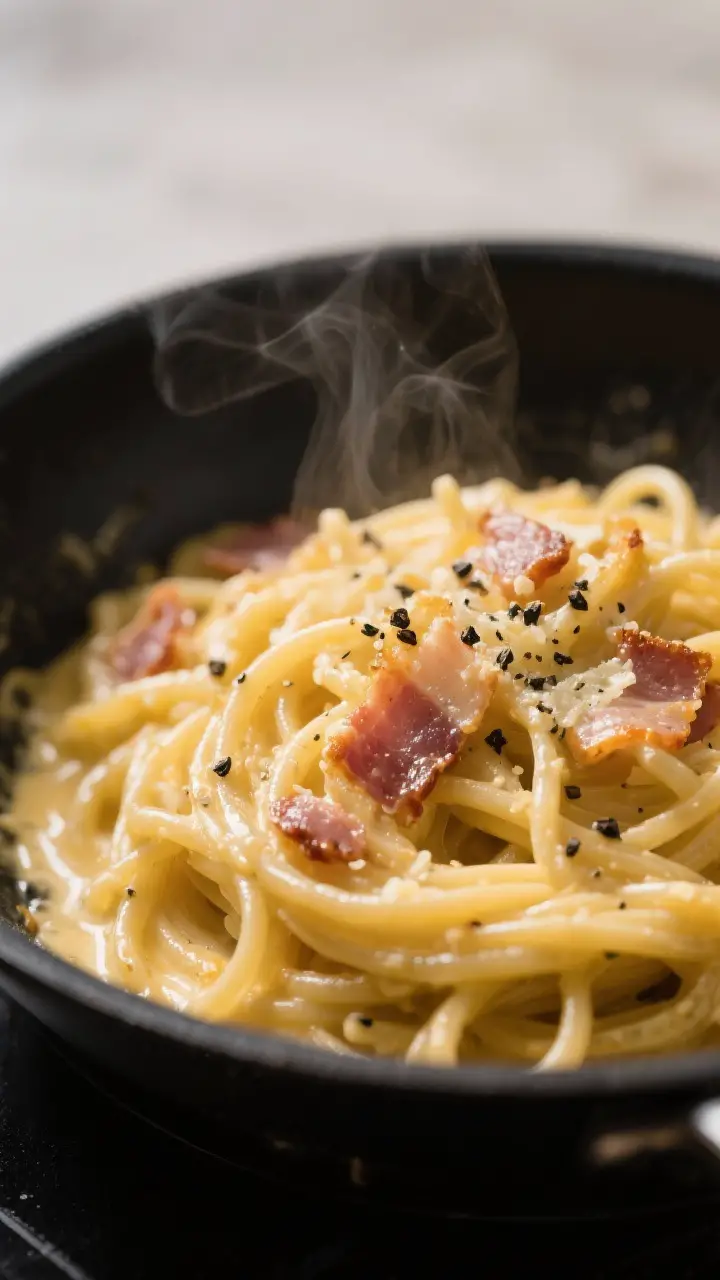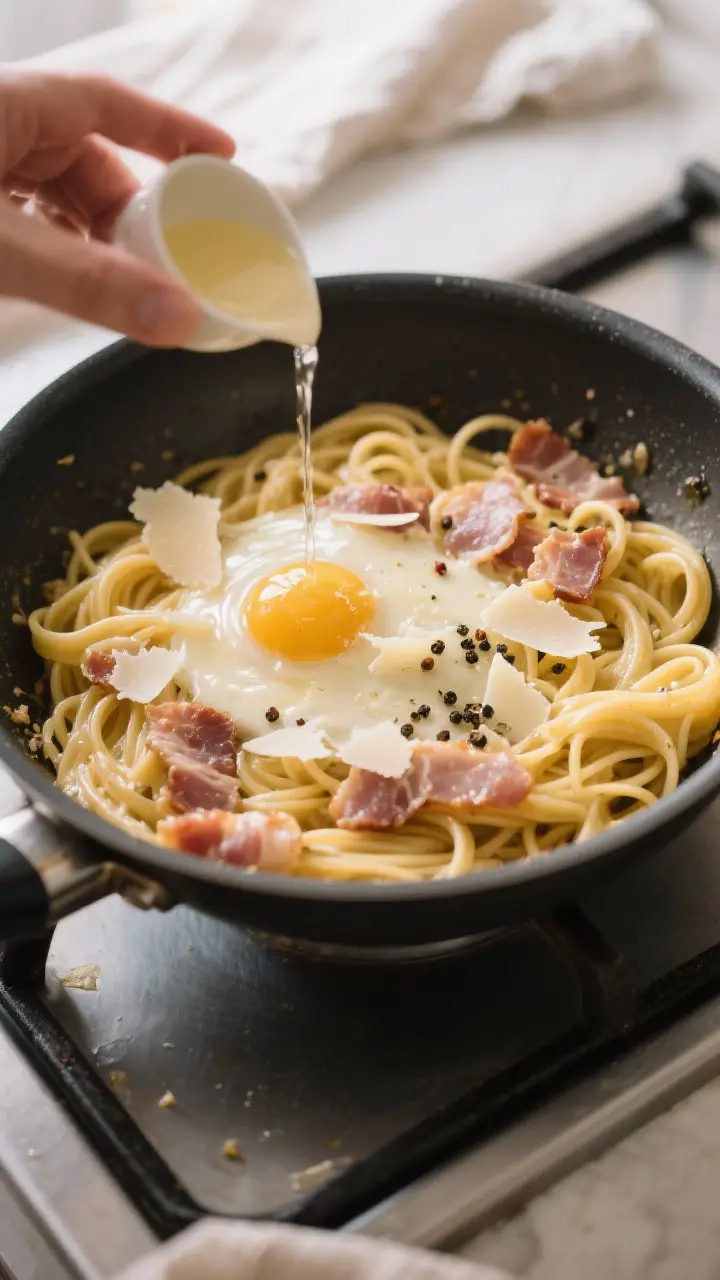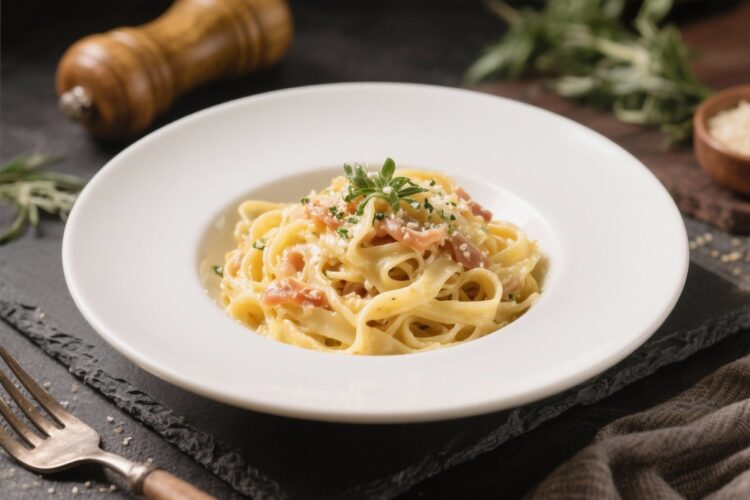Carbonara is that weeknight hero you make once and then keep coming back to. It’s rich without being heavy, simple without feeling plain, and fast enough to pull off between work and whatever comes next. The magic is in the silky sauce made from eggs and cheese—no cream needed.
With a handful of ingredients and a little timing, you’ll get a glossy bowl of comfort in under 30 minutes. If you’ve never tried the traditional method, this is your friendly nudge to give it a go.
What Makes This Special

Classic carbonara is all about technique and restraint. There’s no cream, garlic overload, or fancy extras—just pasta, cured pork, eggs, cheese, and pepper working in perfect sync.
The heat of the pasta cooks the egg mixture gently, creating that signature velvety coating. It’s quick, but it doesn’t feel rushed. Done right, every bite is salty, peppery, and silky with just the right snap from the guanciale.
Shopping List
- Pasta: Spaghetti or rigatoni (about 12 oz/340 g)
- Guanciale: 4–5 oz (115–140 g), diced (pancetta works if needed)
- Eggs: 3 large whole eggs + 1 large yolk (or 4 whole eggs if you prefer)
- Pecorino Romano: 1 cup finely grated (plus extra for serving)
- Black Pepper: freshly cracked, to taste (be generous)
- Kosher Salt: for the pasta water
- Optional: a splash of reserved pasta water to adjust the sauce
Step-by-Step Instructions

- Prep everything first. Finely grate the cheese, dice the guanciale, and crack the eggs into a bowl.
Add the yolk to the eggs and whisk until smooth. Stir in most of the cheese and a generous amount of black pepper. This is your sauce base.
- Boil the pasta. Bring a large pot of water to a rolling boil and salt it well—it should taste like the sea.
Add pasta and cook to just shy of al dente. Reserve at least 1 cup of pasta water before draining.
- Crisp the guanciale. While the pasta boils, place the guanciale in a cold skillet. Turn the heat to medium and cook, stirring occasionally, until golden and crisp and the fat has rendered, about 6–8 minutes. Turn off the heat.
- Temper the egg mixture. Add a small splash (1–2 tablespoons) of hot pasta water to the egg-cheese mixture while whisking.
This helps prevent scrambling later.
- Combine pasta and pork. Transfer the drained pasta to the skillet with the guanciale and rendered fat. Toss to coat. If the pan is very hot, let it cool for 30 seconds.
You want it warm, not sizzling.
- Create the sauce. Pour the egg mixture over the pasta, tossing quickly and continuously. Add splashes of warm pasta water as needed to loosen. The goal is a glossy, creamy sauce that clings to every strand, not scrambled eggs.
- Season and finish. Add more cheese and pepper to taste. If it tightens up, a little more pasta water will bring it back to silky.
Serve immediately with extra Pecorino and cracked pepper.
Keeping It Fresh
Carbonara is best right after it’s made. The sauce sets as it cools, and reheating can turn it grainy. If you do have leftovers, store them in an airtight container for up to a day.
To rewarm, use very low heat with a splash of water, tossing gently until just warm. It won’t be as perfect as fresh, but it’ll still be satisfying.

Health Benefits
- Protein and satisfaction: Eggs and guanciale make this filling, which can help with portion control.
- Calcium and minerals: Pecorino Romano brings calcium and phosphorus.
- Simple, whole ingredients: No heavy cream, no long list of additives—just a few foods used thoughtfully.
- Customizable balance: You can use a whole-grain pasta or add a side of greens for fiber and vitamins without messing with the core flavor.
Pitfalls to Watch Out For
- Scrambled eggs: If the pan is too hot when you add the egg mixture, it will curdle. Pull the pan off heat, wait a few seconds, then add the eggs while tossing quickly.
- Dry, clumpy sauce: You likely need more pasta water or more tossing.
The starch in the water is key to the emulsion.
- Underseasoned pasta water: The sauce relies on proper salting of the water. Don’t skip this.
- Too much cheese at once: Dumping a mountain of cheese without enough water can turn it pasty. Add in stages and adjust with water.
- Wrong cut of pork: Bacon can work in a pinch, but it adds smoke and sweetness.
For authenticity and the right texture, guanciale is best; pancetta is the next best choice.
Variations You Can Try
- All-Pecorino vs. blend: Traditional carbonara favors Pecorino Romano. For a milder, creamier profile, use a 50/50 mix with finely grated Parmigiano-Reggiano.
- Different pasta shapes: Spaghetti is classic. Rigatoni, bucatini, or mezze maniche grab the sauce beautifully.
- Extra pepper kick: Bloom freshly cracked black pepper in the guanciale fat for a spicier, more aromatic finish.
- Whole eggs vs. added yolks: More yolks make it richer and silkier.
If you like it lighter, stick to just whole eggs.
- Vegetable add-ins (non-traditional): If you must, peas or sautéed mushrooms can work, but keep the amounts small so the sauce stays the star.
FAQ
Do I really not use cream?
Correct—no cream in traditional carbonara. The creaminess comes from eggs, cheese, pork fat, and starchy pasta water working together.
How do I avoid scrambling the eggs?
Take the pan off the heat before adding the egg mixture, temper the eggs with a little hot pasta water, and toss quickly. Add pasta water as needed to loosen and keep things moving.
Can I use bacon instead of guanciale?
You can, but it will taste smokier and slightly sweeter.
Pancetta is closer to guanciale if you can’t find it. If you use bacon, choose thick-cut and reduce any added salt.
What cheese is best?
Pecorino Romano is traditional and gives a sharp, salty punch. A blend with Parmigiano-Reggiano softens the edge and makes the sauce a touch creamier.
Is it safe to eat with eggs?
The residual heat gently cooks the eggs as they form the sauce.
If you’re concerned, use very fresh, high-quality eggs. Some people use pasteurized eggs for extra assurance.
Why is my sauce clumpy?
Usually it’s either too hot a pan or not enough liquid. Pull the pan off heat, add a splash of warm pasta water, and toss vigorously to smooth it out.
Can I make it ahead?
Carbonara doesn’t hold well.
You can prep ingredients in advance, but cook and combine just before serving for the best texture.
How much pepper should I use?
Be generous. Carbonara loves pepper. Crack it fresh and taste as you go, adding more at the end if needed.
What’s the ideal pasta doneness?
Cook it just shy of al dente before it hits the pan.
It will finish cooking as you toss it with the sauce, staying springy instead of soft.
Can I make it lighter?
Use fewer yolks, blend some Parm with Pecorino, and consider a whole-grain pasta. Keep portions moderate and pair with a crisp salad.
In Conclusion
Carbonara is proof that a short ingredient list can deliver big comfort. With a little attention to heat and timing, you’ll get a glossy, restaurant-worthy bowl in minutes.
Keep the technique simple, use good ingredients, and don’t be shy with the pepper. Once you nail this quick traditional method, it’ll become your go-to for fast, satisfying dinners any night of the week.
Printable Recipe Card
Want just the essential recipe details without scrolling through the article? Get our printable recipe card with just the ingredients and instructions.

